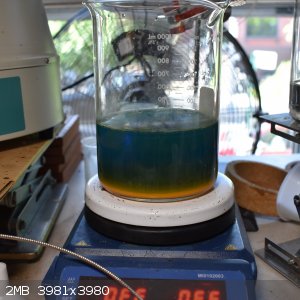Psytophisque
Harmless

Posts: 3
Registered: 31-3-2020
Member Is Offline
|
|
Copper carbonate mystery
Hi all, I tried to find a post that talked about this already but I might be bad at searching. I have a weird orange ppt from mixing sodium carbonate
with what I thought was Cu(II)Cl. Let me tell you the story:
13.1g of stripped copper wire were combined with 50ml ~30% HCl (aq) and an equal volume of 3% H2O2 and heated to 75 C for an
hour.
What I wanted to happen: PCB etching type action to create a strong Cu(II)Cl soln to then neutralize with Na Carbonate and get the
Cu(II)CO3 or basic Cu Carbonate to be specific I guess.
What actually happened: After an hour of heating I cooled the mix which was a light brown rather than the usual green. I decanted it into an equal
volume of DI water, a white ppt formed and the liquid remained a light green.
I assume here, because I essentially boiled out the peroxide in the rxn solution before enough of the copper wire reacted with it, the Cu(II)Cl that
was made turned into a mixture of Cu(II)Cl and Cu(I)Cl since there was an excessive amount of copper wire present.
Once this solid was filtered and retained the remaining rxn soln was neutralized with ~43g of Na Carbonate in a solution of 150ml of DI water. There
was the expected foaming and the solution became turbid but no significant solids were observed until after the first 50ml.
At that point large clouds of yellow orange ppt would develop and redissolve until about 120ml of the Na carbonate has been added at which point the
orange ppt appeared permanently as a fine powder that settled slowly and looks like it is gonna be the biggest pain in the ass to filter.
I have little problems accepting this is the carbonate I was looking for except that the liquid is now an almost copper sulfate blue green. The color
is gorgeous but I don't know what is happening here.
I am guessing I am actually dealing with Cu(I)Cl and got an oddly colored salt of it from the carbonate addition. But if anyone knows or has any idea
of what it might be I would love to hear. I am planning to reacidify with HCl then add some higher concentration peroxide to regenerate Cu(II)Cl, does
that seem like a reasonable plan?

|
|
|
DraconicAcid
International Hazard
    
Posts: 4278
Registered: 1-2-2013
Location: The tiniest college campus ever....
Member Is Offline
Mood: Semi-victorious.
|
|
The yellow/orange stuff may be Cu2O, from the CuCl complex reacting with the basic solution.
Please remember: "Filtrate" is not a verb.
Write up your lab reports the way your instructor wants them, not the way your ex-instructor wants them.
|
|
|
Psytophisque
Harmless

Posts: 3
Registered: 31-3-2020
Member Is Offline
|
|
Thanks for taking the time to share your thoughts, I did some more digging and yeah it is probs the oxide. I will save it I suppose and try again,
less heat and more patience this time.
|
|
|
Bedlasky
International Hazard
    
Posts: 1219
Registered: 15-4-2019
Location: Period 5, group 6
Member Is Offline
Mood: Volatile
|
|
Add more peroxide next time. Metals, metal ionts and heat cause decomposition. And H2O2 also reacts with HCl to form chlorine. These side reactions
consumes your peroxide.
|
|
|